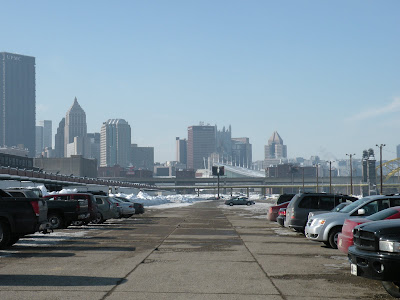
The Strip District is a one-half square mile area northeast of downtown Pittsburgh. Commonly referred to as “The Strip”, it is just what the name states, a narrow strip of land in a flood plain confined by natural boundaries, The Allegheny River to the north and the extension of Grant’s Hill to the south. The Strip starts at 11th street and works it’s way down to 33rd street. At the end of the 18th century, James O’Hara purchased this area along the south bank of the Allegheny River, (which is much of the present day Strip District) as a location for his country home. However, this land was ideal for the development of industrial and commercial enterprises. Throughout the 19th century the Strip began to be the foundation of iron mills, foundries, glass factories, and many other industries to serve the development and many of the names that have been associated with Pittsburgh. The Strip’s location and access to transportation made it ideal for industrial development. Andrew Carnegie started in the iron and steel industries with the Upper and Lower Union Mills on Smallman and 33rd streets.
In the late 19th century wholesale produce merchants were located downtown in the 600 to 900 blocks along Liberty Avenue. During this time railroad tracks ran down Liberty Avenue, this was convenient for the merchants because the trains stopped on the street and produce was unloaded directly into the warehouses. In 1906 the tracks were removed from Liberty Avenue and so the produce merchants relocated to the Strip District near the Pennsylvania Railroad yards. The produce station was relocated at 21st street near Smallman Street, and this intersection became the new hub of the wholesale produce business in Pittsburgh. Through the turn of the century up until the 1920s industrial buildings and shops were torn down and room was made for the construction of produce warehouses and offices. The 1920s was prosperous for Pittsburgh; grocery store chains developed along the Strip District and helped bring business there.
The 1930s was a rough patch for Pittsburgh, the Depression and flood that hit caused tremendous damage and losses throughout businesses. Just as people were about to pull through from the Depression World War II caused a short supply for food and other problems to the city. Railroads were soon replaced with trucks for transporting the produce. Today, the Strip District is best known for its retail produce and ethnic food stores, restaurants and coffee shops. The Strip offers so much, a view of the river to the right and downtown in the background is just one of the treats while walking towards downtown along the Allegheny River. It’s pretty incredible once you find out the background history of the Strip and you see what it has become now.
The photograph above was taken on Penn Avenue in the Strip District, it shows downtown in the background. Today downtown is known as the business district, it features offices for major corporations like PNC Bank, Bank of New York Mellon, Heinz... and many more. While downtown has chain restaurants, the Strip District has an old industrial market type atmosphere with live music and bands playing after dark. In my opinion the Strip surpasses downtown any day!




No comments:
Post a Comment